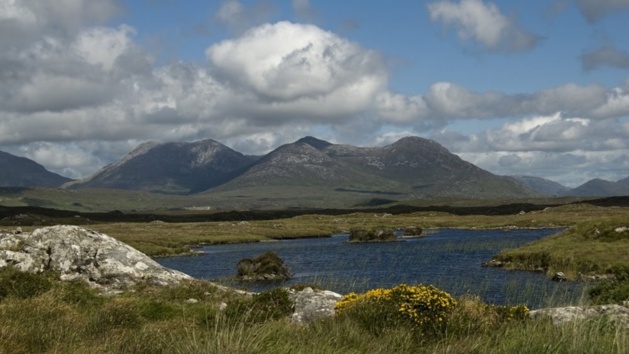
Connemara lakes | Credits -- Patrizia Schiozzi
By the way, talking about pubs… In Dublin I would advise you to avoid Temple Bar (the Garage and Workman’s being the only ones I would recommend). You would rather want to go to Exchequer Street, close to Grafton Street, and try Hogan’s, Grogan’s or Donoghue’s for a more Irish atmosphere. Closer to Trinity College, Doyle’s, The Long Stone and Mac Turcaill’s also are of good value.
Dublin : the Anglo-Irish capital
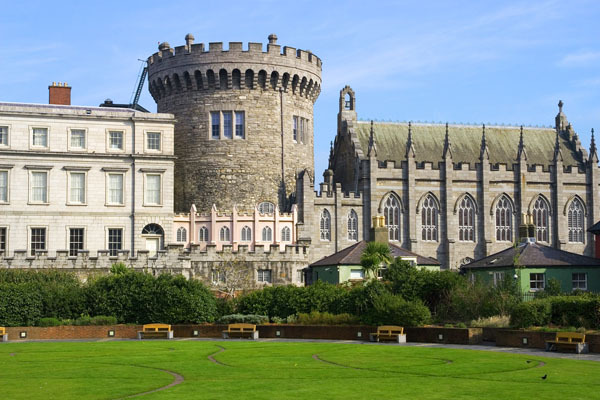
However, summing up Dublin to culture and pubs (or pub culture, as you wish) is not enough. The city displays a rich history. The two cathedrals (Christchurch – Church of England and St Patrick – Catholic) mirror the terrible history of a nation invaded by an enemy who deported its population in the Connemara bogs, imposed its religion and a political system (the monarchy) with which the Irish never really cope. Dublin castle – for a long time the headquarters of the monarchy and palace of the governor and vice-king of Ireland – is another symbol of the Irish-English hatred.
Among other symbols of this Anglo-Irish mix is architecture. Grafton Street, Saint Stephen’s Green and Ballsbridge will remind you more of inner London and its Victorian architecture than Irish bog villages. Most of these houses now host Irish companies or fine-dining restaurants.
Eventually, Phoenix Park, at the very west of the city will obviously remind you of Hyde Park. The Wellington monument watches over Dublin, as if searching for the signs of a rebellion which will never come since the Irish flag now hangs from Phoenix Park-located Áras an Uachtaráin, the official house of the Irish president, Michael D. Higgins. “Irish blood, English heart, this I’m made of…”
Eventually, Phoenix Park, at the very west of the city will obviously remind you of Hyde Park. The Wellington monument watches over Dublin, as if searching for the signs of a rebellion which will never come since the Irish flag now hangs from Phoenix Park-located Áras an Uachtaráin, the official house of the Irish president, Michael D. Higgins. “Irish blood, English heart, this I’m made of…”
Toward the green fields…
But at this stage you might be bored of seeing the rain on the pavement and wonder what the green Irish fields look like. I expect this article to be read by non-UK readers and therefore suppose some of you might be afraid to drive on the left. Do not be afraid! The Dublin Tourist Office proposes a few daily excursions (starting either from O’Connell Street or available via DART transportation). In the north, Malahide (its castle, its beaches on which you will probably never sunbathe) constitutes a charming place. Howth harbour is near and I would strongly recommend you try at least one of its seafood restaurants (you might even see some of the seals which venture in the harbour to be offered fish remains from the restaurants and fishing boats).
Further north is Drogheda and the Boyne Valley which will appeal to History lovers. A large valley in which occurred the battle of the Boyne which opposed the troops of William of Orange (protestant) to the British, catholic and deposed King James (not the James of the Bible). But the valley also hosts a UNESCO world heritage site, Brú na Bóinne, with the Neolithic chamber tombs of Newgrange and Knowth. You may not meet King James who was defeated in 1690 nor will you meet Lord Hennessy, an exiled Irish Catholic Officer who left for France after being defeated and set up a cognac factory (instead of whisky – talk about integration…) on French soil.
Yet you will be impressed by the genius of the first men who designed these thumbs in such a way that they would be lit by the sun two days a year, during the solstices. Drogheda is about 40 minutes far from Dublin and the chamber tombs are worth the trip (departure from O’Connell Street, tickets to be bought at the Tourist Office).
Further north is Drogheda and the Boyne Valley which will appeal to History lovers. A large valley in which occurred the battle of the Boyne which opposed the troops of William of Orange (protestant) to the British, catholic and deposed King James (not the James of the Bible). But the valley also hosts a UNESCO world heritage site, Brú na Bóinne, with the Neolithic chamber tombs of Newgrange and Knowth. You may not meet King James who was defeated in 1690 nor will you meet Lord Hennessy, an exiled Irish Catholic Officer who left for France after being defeated and set up a cognac factory (instead of whisky – talk about integration…) on French soil.
Yet you will be impressed by the genius of the first men who designed these thumbs in such a way that they would be lit by the sun two days a year, during the solstices. Drogheda is about 40 minutes far from Dublin and the chamber tombs are worth the trip (departure from O’Connell Street, tickets to be bought at the Tourist Office).
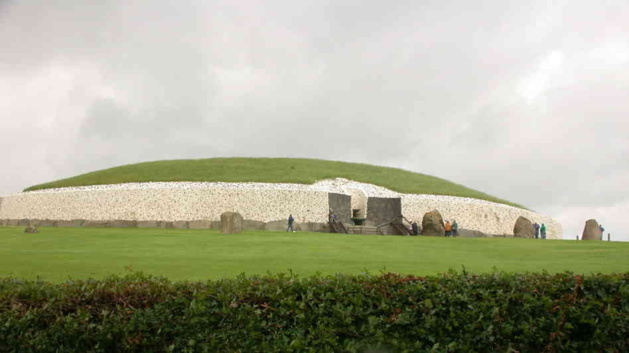
And if the idea of going further north already makes you shivering, why not going south, to Glendalough and the Wicklow mountains? The lake and the monastic site will charm Nature lovers while beer lovers will seek to find out what makes Guinness taste so peculiar (to give you a clue, it has something to do with the water…). You don’t like monasteries? Then the DART can also take you to Dalkey, a charming coastal village where you might be able to have a long chat with Bono who is a regular customer of its pubs.
On the road…
Like the Pioneers going to California, here you are, heading West! You might have rented a car (for the bravest who dared driving on the left) or you opted for a bus company (Gobus, Citylink –both private companies -or BusEireann – a PLC). For once, let’s trample on journalistic principles and be completely subjective: in Ireland pick a private company anytime you can! Why? For two reasons: firstly it will prove cheaper and secondly you will reach your destination quicker. Travelling with private companies you might not see numerous sheeps on the way as they operate on the main highways but you will at least enjoy the pleasure of being carried on brand new highways partly financed by your taxes if you are European (Irish highways having been financed mostly by the EU).
If you have a car and are on the road Dublin-Galway, I would advise you stop in Clonmacnoise, an impressive monastic site where you will walk in the footsteps of John Paul II who celebrated a mass there in 1979. If you or the car need a stopover (the road westward is long), the Kilbeggan Distillery is a must see.
If you have a car and are on the road Dublin-Galway, I would advise you stop in Clonmacnoise, an impressive monastic site where you will walk in the footsteps of John Paul II who celebrated a mass there in 1979. If you or the car need a stopover (the road westward is long), the Kilbeggan Distillery is a must see.
Galway or the Gate to Connemara
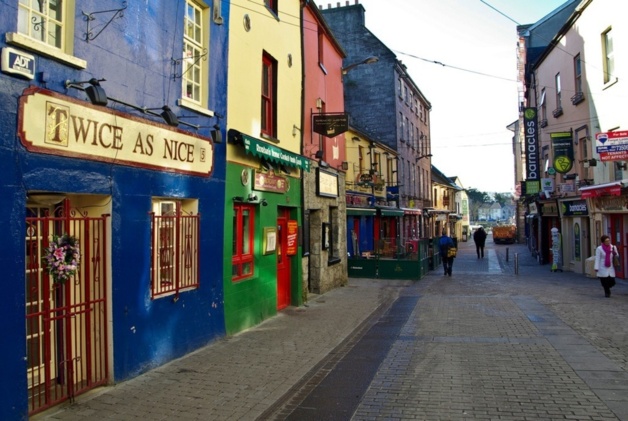
Connemara is a bog. A windy and inhabited swamp. Its soil is mainly composed of turf which is still extracted by local farmers to be used as fuel. Galway and Clifden are the main cities in that bog, with Galway being the fourth city in the country. Mostly populated by students during the year it is invaded by tourists during the summer. The city hosts an artistic festival (the Arts Festival), a cinema festival (the Galway Film Fleadh), a horse-race week and for the last two years welcomed the Volvo Ocean Race (a boat race around the world) in July and August. It is a very lively city in summer which falls asleep again in September to look like the natural harbour it is.
When it comes to food, Galway is probably one of the best food cities I have visited in Ireland. Whether you fancy Spanish (Lunares on Woodquay), Japanese (Kappa-Ya on Middle Street) or fancy discovering Irish “terroir cuisine” in Nimmos, Kai Café or Aniar (on the Spanish Arch for Nimmos and near Dominick Street for the two others), you will find every cuisine there. Populated by hippies, local restaurants are also close to Mother Nature and propose numerous vegetarian options. Products are locally sourced (at least in the aforementioned restaurants) and the market (Saturday and Sunday mornings on Church Yard Street) will remind you of the “marchés” in Southern France (the rain as a bonus). Galway is a city which can easily be used as a basecamp to visit the region.
When it comes to food, Galway is probably one of the best food cities I have visited in Ireland. Whether you fancy Spanish (Lunares on Woodquay), Japanese (Kappa-Ya on Middle Street) or fancy discovering Irish “terroir cuisine” in Nimmos, Kai Café or Aniar (on the Spanish Arch for Nimmos and near Dominick Street for the two others), you will find every cuisine there. Populated by hippies, local restaurants are also close to Mother Nature and propose numerous vegetarian options. Products are locally sourced (at least in the aforementioned restaurants) and the market (Saturday and Sunday mornings on Church Yard Street) will remind you of the “marchés” in Southern France (the rain as a bonus). Galway is a city which can easily be used as a basecamp to visit the region.
Connemara, the Burren or the Aran Islands?
From Galway, three excursions are available by bus: Connemara and Kylemore Abbey, a charming abbey located by a lake in the middle of an oak forest surrounded by two high mountains. The location is picturesque. The Abbey (formerly a castle) was built by a British Lord whose wife fell in love with the place. By going on this tour you will also be able to see Ireland’s unique fjord (in Killary Harbour, in the north). While driving there, try to imagine the life of the thousands of Irish farmers deported there by Cromwell during the plantation…
Going southward you will visit the Burren and its limestone hills, County Clare and its dolmens and finally the breath-taking Cliffs of Moher which are among the highest in Europe, rising up to 200 meters above sea-level. They were used as a set for the shooting of Harry Potter VI (remember the scene where Harry and Dumbledore are about to enter the cave were they will find the fake horcrux!). If the weather is clear you will see Connemara on the other side of Galway Bay as well as the Aran Islands (Inis Mór – the biggest, Inis Meáin and Inis Óirr – the smallest).
These islands constitute the third excursion available from Galway. You can reach them from the port of Doolin (County Clare) or Rossaveel (County Galway). They are definitely worth the trip with their fields covered in stone and the traditional Irish spirit they convey. Covered in stone walls, they are the Ireland you have so far only seen on postal cards. The walls are a memory of the time when British heritance law imposed fathers to split their lands equally between their children – therefore reducing the size of the lands and making it impossible to live from agriculture (yields too small). Rough and windy, the isles are the living memory of Ireland (as immortalised by James Joyce in its famous novel “The Dead”).
Located in the middle of the Gaeltacht, the virtual region created by the Irish government to protect Gaelic and Irish culture, you will find there picturesque locations, historical vestiges (Dun Anegus castle on Inis Mór – which I recommend) and excellent local craftsmanship (woollen sweaters, hats, scarves – if you want to buy tweed items you will have to go further north in Donegal). I do hope, however, that you like cycling as the isles are forbidden to private cars. You don’t like cycling? Horse-drawn cars are also available.
These islands constitute the third excursion available from Galway. You can reach them from the port of Doolin (County Clare) or Rossaveel (County Galway). They are definitely worth the trip with their fields covered in stone and the traditional Irish spirit they convey. Covered in stone walls, they are the Ireland you have so far only seen on postal cards. The walls are a memory of the time when British heritance law imposed fathers to split their lands equally between their children – therefore reducing the size of the lands and making it impossible to live from agriculture (yields too small). Rough and windy, the isles are the living memory of Ireland (as immortalised by James Joyce in its famous novel “The Dead”).
Located in the middle of the Gaeltacht, the virtual region created by the Irish government to protect Gaelic and Irish culture, you will find there picturesque locations, historical vestiges (Dun Anegus castle on Inis Mór – which I recommend) and excellent local craftsmanship (woollen sweaters, hats, scarves – if you want to buy tweed items you will have to go further north in Donegal). I do hope, however, that you like cycling as the isles are forbidden to private cars. You don’t like cycling? Horse-drawn cars are also available.
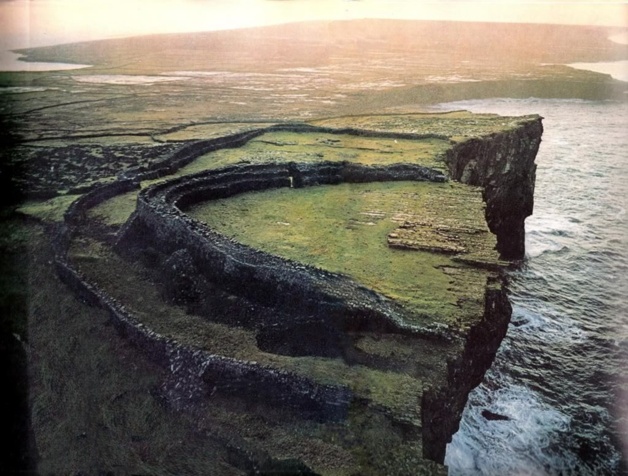
After all these excursions, you are ready for a crazy night in Galway! Among all the cities I visited, it is by far one of the liveliest at night. Neactain’s, Busker Brownes, the Front Door, the Roisin Dubh, Massimo’s (start from Eyre Square, go down Shop Street and cross the bridge to turn toward Dominick Street) are waiting for you! Be up to the Irish challenge!






























